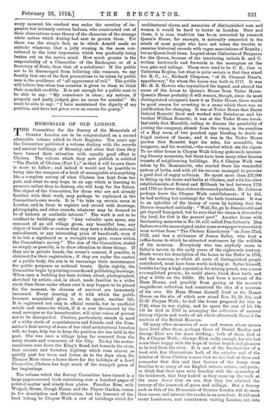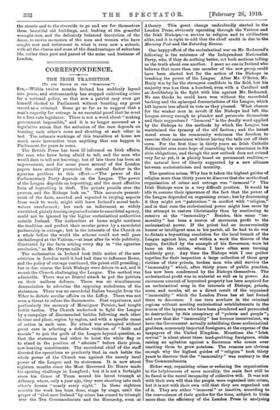MEMORIALS OF OLD LONDON.
THE Committee for the Survey of the Memorials of Greater London are to be congratulated on a second admirable volume added to their Register. Ten years ago the Committee published a volume dealing with the records and ancient buildings of Bromley, and since that time they have turned their attention with equally good effect to Chelsea. The volume which they now publish is entitled "The Parish of Chelsea (Part I.)," so that it will be seen there is more to follow ; and indeed it would not be possible to bring into the compass of a book of manageable size anything like a complete survey of what Chelsea has kept from her past, and what we may hope, in an age which is learning to preserve rather than to destroy, she will keep for the future. The object of the Committee, for those who are not already familiar with their work, may perhaps be explained in the Committee's own words. It is "to take up certain areas in London, and in them to register and record with drawings, photographs, and other records, whatever may be deemed to be of historic or aesthetic interest." The work is not to be confined to buildings only. "Any valuable open space, any remnant of an old village green, any beautiful tree, any object of local life or custom that may have a definite external embodiment, or any interesting piece of handicraft, even if it be but a signboard or a wrought-iron gate, comes within the Committee's survey." The aim of the Committee, stated as simply as possible, is to draw attention to these things. If they are in private bands, the owner's consent, if possible, is obtained for their registration ; if they are under the control of a public body, the aim is to encourage their maintenance for public purposes as national trusts. Quite rightly, the Committee begin by printing records and publishing drawings. When once a building has been written about, photographed, sketched by artists, and, in short, made familiar to a wider circle than those under whose care it may happen to be placed for the moment, its chances of survival are immensely increased. Every drawing of it with which the public becomes acquainted gives it, so to speak, another life. It is registered not only in official records, but in unofficial minds and memories which, if it is ever threatened by the road surveyoror the housebreaker, will raise voices of protest not to be disregarded. Chelsea, particularly, stands in need of a wider circle of acquaintances and friends, and the Com- mittee's first survey of some of her chief architectural beauties will, we hope, help her to keep the position she has held in the past. She was once a village lying far removed from the noisy streets and commerce of the City. To-day the motor- omnibuses roar down the King's Road, but towards the river, that ancient and forsaken highway which runs almost as quietly past her trees and lawns as in the days when Sir Thomas More chose a home there for the holidays of a Lord Chancellor, Chelsea has kept much of the tranquil grace of her beginnings.
The volume which the Survey Committee have issued is a large paper-covered book containing over a hundred pages of printed matter and ninety-four plates. Paradise Row, with Walpole House, Gough House, and the Physic Garden, comes in for description and illustration, but the honours of the book belong to Cheyne Walk. a row of buildings which for
architectural charm and memories of distinguished men and women it would be hard to better in London. Here and there, it is true, tradition has be en corrected by research Queen's House, for example, is naturally connected in the minds of most people who have not taken the trouble to examine historical records with vague associations of Royalty ; but no Queen lived there. Legend chose Catherine of Braganza for the Queen, because of the interlacing initials R. and C. written backwards and forwards in the monogram on the iron gate and railings. These were read to be C. R., that is, Catherine Regina, but what is quite certain is that they stand for R. C., i.e., Richard Chapman, "of St. Clement Dane's, appothecary," for whom the house was built in 1717. It was Mr. H. R. Haweis who crystallised the legend, and altered the name of the house to Queen's House from Tudor House. Queen's House probably it will remain, though, since its most distinguished occupants knew it as Tudor House, there would be good reason for reverting to a name which there was no justification for changing. It was at Tudor House that Dante Gabriel Rossetti lived and worked with Swinburne and his brother William Rossetti ; it was at the Tudor House break- fast-table that Meredith, calling to discuss the possibility of joining the company, shrank from the vision, in the sunshine of a May noon, of two poached eggs bleeding to death on frigid rashers of bacon; and it was in the Tudor House garden that Rossetti kept his zebu, his armadillo, his kangaroo, and his wombat,—the wombat which ate the cigars. To no other house in Cheyne Walk belong quite such interest- ing literary memories, but there have been many other famous tenants of neighbouring buildings. No. 6 Cheyne Walk was taken by Dr. Dominicetti, who started there his wonderful system of baths, and with all his success managed to provoke a good deal of angry criticism. He spent more than 237,000 in fitting up his house and baths at Chelsea, and with his other establishments at Bristol and Milbank he had between 1755 and 1780 no fewer than sixteen thousand patients. Dr. Johnson perhaps knew the Cheyne Walk establishment ; if he did, he had nothing but contempt for the bath treatment. It was to an upholder of the theory of cures by bathing that the Doctor remarked unkindly : "Well, Sir, go to Dominicetti and get thyself fumigated, but be sure that the steam is directed to thy head, for that is the peceast part." Another house with fascinating memories is No.18, still called Don Saltero's. Don Saltero was the name signed under some newspaper verses which were written from "The Chelsea Knackatory " on June 22nd, 1723, and was a nickname of James Salter, who kept a coffee-house to which he attracted customers by the exhibits of his museum. Everybody who was anybody came to Salter's tavern in the early years of the eighteenth century. Steele wrote his description of the house in the Taller in 1708, and the museum, to which all sorts of distinguished people contributed, must have been worth looking at. Salter himself, besides having a high reputation for mixing punch, was a most accomplished person ; he could shave, bleed, draw teeth, and play a little on the fiddle. He had been a servant of Sir Hans Sloane, and possibly from gazing at his master's magnificent collection bad conceived the idea of a museum of his own. Sir Hans Sloane himself lived at the Manor House. on the site of which now stand Nos. 19, 20, 20A, and 21-26 Cheyne Walk ; he had the house prepared for him in 1742, when he was eighty, and he spent the rest of his life till he died in 1753 in arranging the collection of natural history objects and works of art which afterwards formed the nucleus of the British Museum.
Of many other memories of men and women whose names have lived after them, perhaps those of Daniel Maclise and George Eliot are the most striking ; both of them died at No. 4 Cheyne Walk,—George Eliot sadly enough, for she had come there happy with the hope of better health and pleasure to be had from the river. It is one of the fascinations of a book with fine illustrations both of the exterior and of the interior of these Chelsea houses that we can look at them and remember that this and that feature of the house were familiar to so many of our English writers, artists, and poets ; to think that their eyes were familiar with the symmetry of the brickwork, that they looked as they came up the walk at the same doors that we see, that they too admired the tracery of the ironwork of gates and railings. But a Survey such as this of the Memorials of Greater London will do more than amuse and interest the reader in an armchair. It will send many Londoners, and countrymen visiting London, out into
the streets and to the riverside to go and see for themselves these beautiful old buildings, and, looking at the graceful wrought-iron and the delicately balanced decoration of the doors, to revive memories of the men and women who have sought rest and retirement in what is even now a suburb, with all the charm and none of the disadvantages of suburban life, rather than part and parcel of the noise and business of London.











































 Previous page
Previous page